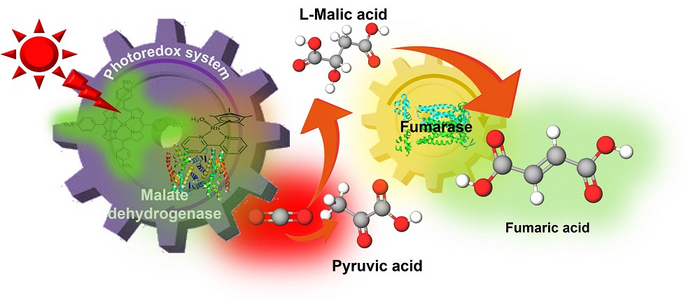Osaka, Japan – In recent years, environmental problems caused by global warming have become more apparent due to greenhouse gases such as CO2. In natural photosynthesis, CO2 is not reduced directly, but is bound to organic compounds which are converted to glucose or starch. Mimicking this, artificial photosynthesis could reduce CO2 by combining it into organic compounds to be used as raw materials, which can be converted into durable forms such as plastic.

Credit: Yutaka Amao, Osaka Metropolitan University
Osaka, Japan – In recent years, environmental problems caused by global warming have become more apparent due to greenhouse gases such as CO2. In natural photosynthesis, CO2 is not reduced directly, but is bound to organic compounds which are converted to glucose or starch. Mimicking this, artificial photosynthesis could reduce CO2 by combining it into organic compounds to be used as raw materials, which can be converted into durable forms such as plastic.
A research team led by Professor Yutaka Amao from the Research Center for Artificial Photosynthesis and graduate student Mika Takeuchi, from the Osaka Metropolitan University Graduate School of Science, have succeeded in synthesizing fumaric acid from CO2, a raw material for plastics, powered—for the first time—by sunlight. Their findings were published in Sustainable Energy & Fuels.
Fumaric acid is typically synthesized from petroleum, to be used as a raw material for making biodegradable plastics such as polybutylene succinate, but this discovery shows that fumaric acid can be synthesized from CO2 and biomass-derived compounds using renewable solar energy.
“Toward the practical application of artificial photosynthesis, this research has succeeded in using visible light—renewable energy—as the power source,” explained Professor Amao. “In the future, we aim to collect gaseous CO2 and use it to synthesize fumaric acid directly through artificial photosynthesis.”
###
About OMU
Osaka Metropolitan University is a new public university established by a merger between Osaka City University and Osaka Prefecture University in April 2022. For more science news, see https://www.omu.ac.jp/en/, and follow @OsakaMetUniv_en, or search #OMUScience.
Journal
Sustainable Energy & Fuels
DOI
10.1039/D2SE01533A
Method of Research
Experimental study
Subject of Research
Not applicable
Article Title
Visible-light driven fumarate production from CO2 and pyruvate by the photocatalytic system with dual biocatalysts
Article Publication Date
13-Dec-2022




